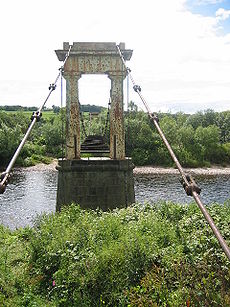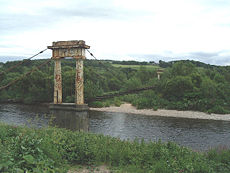
Shakkin' Briggie
Encyclopedia


Suspension bridge
A suspension bridge is a type of bridge in which the deck is hung below suspension cables on vertical suspenders. Outside Tibet and Bhutan, where the first examples of this type of bridge were built in the 15th century, this type of bridge dates from the early 19th century...
footbridge
Footbridge
A footbridge or pedestrian bridge is a bridge designed for pedestrians and in some cases cyclists, animal traffic and horse riders, rather than vehicular traffic. Footbridges complement the landscape and can be used decoratively to visually link two distinct areas or to signal a transaction...
which crosses the River Dee
River Dee, Aberdeenshire
The River Dee is a river in Aberdeenshire, Scotland. It rises in the Cairngorms and flows through Strathdee to reach the North Sea at Aberdeen...
from Ardoe to Cults near Aberdeen
Aberdeen
Aberdeen is Scotland's third most populous city, one of Scotland's 32 local government council areas and the United Kingdom's 25th most populous city, with an official population estimate of ....
in Scotland
Scotland
Scotland is a country that is part of the United Kingdom. Occupying the northern third of the island of Great Britain, it shares a border with England to the south and is bounded by the North Sea to the east, the Atlantic Ocean to the north and west, and the North Channel and Irish Sea to the...
.
History
The foundation stone was place on 27 August 1836, and the bridge was opened in 1837. It was funded by Rev. Dr. George Morison (1758 - 1845), at a cost of £1,400. Morison, son of Aberdeen ProvostProvost (civil)
A provost is the ceremonial head of many Scottish local authorities, and under the name prévôt was a governmental position of varying importance in Ancien Regime France.-History:...
Robert Morison, was the minister at the Banchory-Devenick Parish Church from 1785, and inherited his elder brother Thomas' estate. He carried out work on behalf of his parishioners including arranging distribution of vaccines, supply of food during the 1800 famine, setting up a savings bank, and building a school.
Morison proposed the bridge to link his church on the south bank of the Dee to 700 parishioners resident on the north bank, who were at the time crossing to the church by boat every Sunday. The bridge was designed by Aberdeen's City Architect John Smith, who had previously worked with Captain Samuel Brown on the Wellington Suspension Bridge in Aberdeen, who helped Thomas Telford
Thomas Telford
Thomas Telford FRS, FRSE was a Scottish civil engineer, architect and stonemason, and a noted road, bridge and canal builder.-Early career:...
design the Bridge of Don, and who designed the nearby Bridge of Dee
Bridge of Dee
The Bridge of Dee or Brig o' Dee is a road bridge over the River Dee in Aberdeen, Scotland. The term is also used for the surrounding area of the city. Dating from 1527, the bridge crosses at what was once the City of Aberdeen's southern boundary...
. St. Devenick's Bridge was Smith's only solo suspension bridge design.
The bridge spans
Span (architecture)
Span is the distance between two intermediate supports for a structure, e.g. a beam or a bridge.A span can be closed by a solid beam or of a rope...
54.9 metres (180 feet) between stone piers
Pier (architecture)
In architecture, a pier is an upright support for a superstructure, such as an arch or bridge. Sections of wall between openings function as piers. The simplest cross section of the pier is square, or rectangular, although other shapes are also common, such as the richly articulated piers of Donato...
and cast iron
Cast iron
Cast iron is derived from pig iron, and while it usually refers to gray iron, it also identifies a large group of ferrous alloys which solidify with a eutectic. The color of a fractured surface can be used to identify an alloy. White cast iron is named after its white surface when fractured, due...
towers. The suspension chains comprise 3 inches (76.2 mm), 6 feet (1.8 m) cast-iron bars, anchored into stone anchor blocks. The southern anchor block is now in the middle of the river, which has changed course considerably since the bridge was built. The timber bridge deck and parapet
Parapet
A parapet is a wall-like barrier at the edge of a roof, terrace, balcony or other structure. Where extending above a roof, it may simply be the portion of an exterior wall that continues above the line of the roof surface, or may be a continuation of a vertical feature beneath the roof such as a...
s were built by Morison's friend George Barclay. The lack of any significant metal stiffening of the bridge deck led to a flexibility which gave the bridge its popular name.
The foundations and piers were built by George Donaldson, and the iron parts cast by George Duffus & Co.
After Morison's death, the bridge was maintained by the Kirk Session. At present, it is unclear if any body has legal responsibility for the bridge. A newspaper headline in 1958 stated that it was The Bridge That Nobody Owns. Although its legal status remains unclear, Aberdeen City Council
Aberdeen City Council
Aberdeen City Council represents the Aberdeen City council area of Scotland.The council area was created in 1996, under the Local Government etc. Act 1994...
is currently active in considering the bridge's future.
Damage
The bridge was damaged by floods in 1876, 1914 and most seriously in October 1920, when floodwaters rose above the level of the bridge deck. Public funds were sought and the bridge reopened in September 1922. However, due to erosion, the Dee shifted its course from 1955 onwards, sweeping away the southern approach spans, and in 1984 the decking was removed as a safety precaution. The bridge is a Category A listed structure, and is now derelict.Plans for Restoration
In recent years (as of 2007) plans have been made to restore the bridge and extend it to the south bank. It was proposed to form a Trust to take on responsibility for the bridge. However, funding for restoration (estimated at £775,000 in 1990) has not been secured.See also
- The Shakey Bridge - Pedestrian bridge in CorkCork (city)Cork is the second largest city in the Republic of Ireland and the island of Ireland's third most populous city. It is the principal city and administrative centre of County Cork and the largest city in the province of Munster. Cork has a population of 119,418, while the addition of the suburban...
, IrelandRepublic of IrelandIreland , described as the Republic of Ireland , is a sovereign state in Europe occupying approximately five-sixths of the island of the same name. Its capital is Dublin. Ireland, which had a population of 4.58 million in 2011, is a constitutional republic governed as a parliamentary democracy,...

